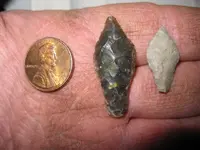larson1951
Silver Member
- Joined
- Apr 8, 2009
- Messages
- 4,962
- Reaction score
- 3,893
- Golden Thread
- 0
- Location
- North Dakota
- Detector(s) used
- tesoro
- Primary Interest:
- Other
I find many different styles of points in the same field
must have been many occupants over many years
now what are these ?
must have been many occupants over many years
now what are these ?
Attachments
Upvote
0




